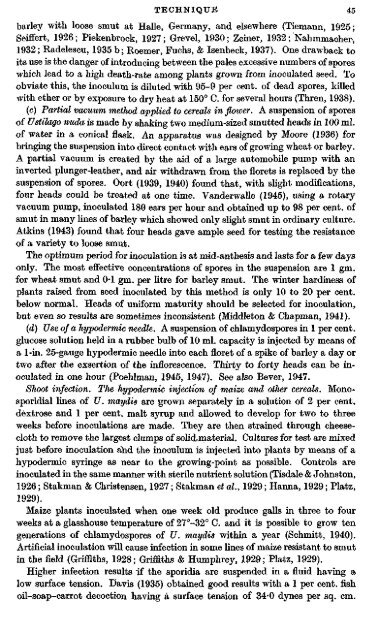nmm sP
nmm sP
nmm sP
You also want an ePaper? Increase the reach of your titles
YUMPU automatically turns print PDFs into web optimized ePapers that Google loves.
TECHNIQUE 45<br />
barley with loose smut at HaUe, Germany, and elsewhere (Tiemann, 1925;<br />
Seiffert, 1926; Piekenbrock, 1927 ; Grevel, 1930; Zeiner, 1932; Nahmmaoher,<br />
1932; Radelescu, 1935 b; Roemer, Fuchs, & Isenbeck, 1937). One drawback to<br />
its use is the danger of introducing between the pales excessive numbers of spores<br />
which lead to a high death-rate among plants grown from inoculated seed. To<br />
obviate this, the inoculum is diluted with 95-9 per cent, of dead spores, kiUed<br />
with ether or by exposure to dry heat at 150° C. for several hours (Thren, 1938).<br />
(c) Partial vacuum method applied to cereals in flower. A suspension of spores<br />
of Ustilago nuda is made by shaking two medium-sized smutted heads in 100 ml.<br />
of water in a conical flask. An apparatus was designed by Moore (1936) for<br />
bringing the suspension into direct contact with ears of growing wheat or barley.<br />
A partial vacuum is created by the aid of a large automobUe pump with an<br />
inverted plunger-leather, and air withdrawn from the florets is replaced by the<br />
suspension of spores. Oort (1939, 1940) found that, with slight modifications,<br />
four heads could be treated at one time. Vanderwalle (1945), using a rotary<br />
vacuum pump, inoculated 180 ears per hour and obtained up to 98 per cent, of<br />
smut in many lines of barley which showed only slight smut in ordinary culture.<br />
Atkins (1943) found that four heads gave ample seed for testing the resistance<br />
of a variety to loose smut.<br />
The optimum period for inoculation is at mid-anthesis and lasts for a few days<br />
only. The most efiective concentrations of spores in the suspension are 1 gm.<br />
for wheat smut and 0-1 gm. per litre for barley smut. The winter hardiness of<br />
plants raised from seed inoculated by this method is only 10 to 20 per cent,<br />
below normal. Heads of uniform maturity should be selected for inoculation,<br />
but even so results are sometimes inconsistent (Middleton & Chapman, 1941).<br />
{d) Use of a hypodermic needle. A suspension of chlamydospores in 1 per cent,<br />
glucose solution held in a rubber bulb of 10 ml. capacity is injected by means of<br />
a 1-in. 25-gauge hypodermic needle into each floret of a spike of barley a day or<br />
two after the exsertion of the inflorescence. Thirty to forty heads can be inoculated<br />
in one hour (Poehlman, 1945, 1947). See also Bever, 1947.<br />
Shoot infection. The hypodermic injection of maize and other cereals. Monosporidial<br />
lines of U. maydis are grown separately in a solution of 2 per cent,<br />
dextrose and 1 per cent, malt syrup and allowed to develop for two to three<br />
weeks before inoculations are made. They are then strained through cheesecloth<br />
to remove the largest clumps of sohdjuaterial. Cultures for test are mixed<br />
just before inoculation and the inoculum is injected into plants by means of a<br />
hypodermic syringe as near to the growing-point as possible. Controls are<br />
inoculated in the same manner with sterile nutrient solution (Tisdale & Johnston,<br />
1926; Stakman & Christensen, 1927 ; Stakman et al, 1929; Hanna, 1929; Platz,<br />
1929).<br />
Maize plants inoculated wben one week old produce gaUs in three to four<br />
weeks at a glasshouse temperature of 27°-32° C. and it is possible to grow ten<br />
generations of chlamydospores of U. maydis within a year (Schmitt, 1940).<br />
Artificial inoculation will cause infection in some lines of maize resistant to smut<br />
in the field (Grifliths, 1928; Griffiths & Humphrey, 1929; Platz, 1929).<br />
Higher infection results if the sporidia are suspended in a fluid having a<br />
low surface tension. Bavis (1935) obtained good results with a 1 per cent, fish<br />
oil-soap-carrot decoction having a surface tension of 34-0 dynes per sq. cm.

















